Mises, Ludwig von. Human Action: A Treatise on Economics
Подождите немного. Документ загружается.


294
Human
Action
In the group of labor all derive a lasting gain from the increase in
the marginal productivity of labor. But, on the other hand, in the
short run some may suffer disadvantages. These are people who were
specialized in the performancc of work which becomes obsolete
as a result of technological improvement and are fitted only for jobs
in which-in spite of the general rise in wage rates-they earn less
than before.
All these changes in the prices of the factors of production begin
immediately with the initiation of the entrepreneurial actions designed
to adjust the processes of production to the new state of affairs. In
dealing with this problem as with the other problems of changes
in
the market data, we must guard ourselves against the popular fallacy
of drawing a sharp line between short-run and long-run effects. What
happens in the short run is precisely the first stages of the chain of
successive transformations which tend to bring about the long-run
effects. The long-run effect is in our case the disappearance of entre-
preneurial profits and losses. The short-run effects are the preliminary
stages of this process of elimination which finally, if not interrupted
by a further change in the data, would result in the cmergence of
the evenly rotating economy.
It is necessary to comprehend that the very appearance of an ex-
cess in the total amount of entrepreneurial profits ovcr
the
total
amount of entrepreneurial losses depends upon the fact that this
process of the elimination of entrepreneurial profit and loss begins at
the same time as the entrepreneurs begin to adjust the complex of
production activities to the changed data. There is never in the whole
sequence of events an instant in which the advantages derived from
the increase in the amount of capital available and from technical
improvements benefit the entrepreneurs only. If the wealth and the
income of the other strata were to remain unaffected, these people
couId buy the additional products only
by
restricting their pur-
chases of other products accordingly. Thcn the profits of one group
of entrepreneurs would exactly equal the losses incurred by other
groups.
What happens is this: The entrepreneurs embarking upon the uti-
lization of the newly accumulated capital goods and the improved
technological methods of production are in need of complementary
factors of production. Their demand for these factors is
a
new
ad-
ditional demand which must raise their prices. Only as far as this rise
in prices and wage rates occurs, are the consumers in a position to buy
the new products without curtailing the purchase of other goods.
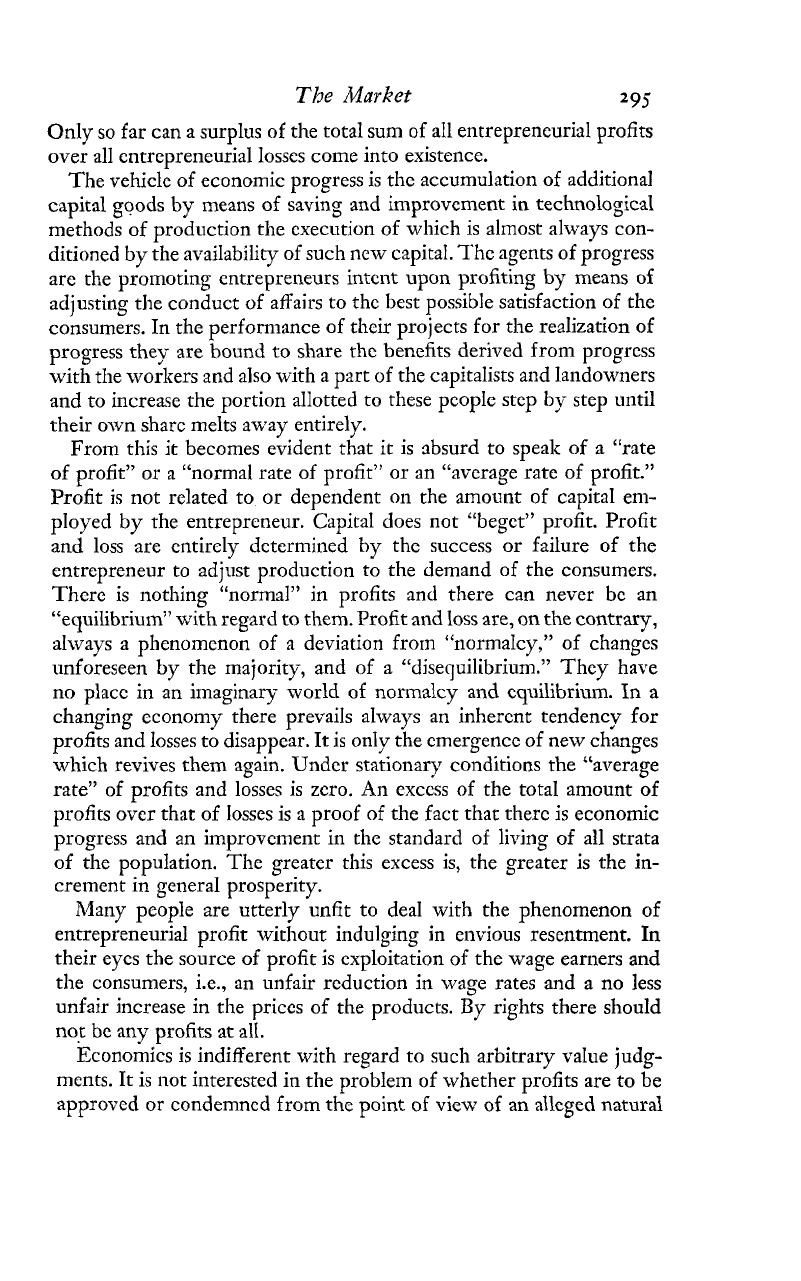
The
Market
Only so far can a surplus of the total sum of a11 entrepreneurial profits
over all entrepreneurial losses come into existence.
The vehicle of economic progress is the accumulation of additional
capital goods by means of saving and improvement in technological
methods of production the execution of which is almost always con-
ditioned by the availability of such new capitaI. The agents of progress
are the promoting entrepreneurs intent upon profiting by means of
adjusting the conduct of affairs to the best possible satisfaction of the
consumers. In the performance of their projects for the realization of
progress they are bound to share the benefits derived from progress
with the workers and also w-ith a part of the capitalists and landowners
and to increase the portion allotted to these people step by step until
their own sharc melts away entirely.
From this it becomes evident that
it
is absurd to speak of a "rate
of profit" or a "normal rate of profit" or an "average rate of profit."
Profit is not related to or dependent
on
the amount of capital em-
ployed by the entreprcneur. Capital does not "beget" profit. Profit
and loss are entircly determined
by
the success or failure of the
entrepreneur to adjust production to the demand of the consumers.
There is nothing "normal" in profits and there can never be an
"equilibrium" with regard to them. Profit and loss are, on the contrary,
always a phenomcnon of a deviation from "normalcy," of changes
unforeseen by the majority, and of a "disequilibrium." They have
no place in an
imaginary
world of normalcy and equilibrium.
In
a
changing cconomy there prevails always an inhercnt tendency for
profits and losses to disappear. It is only the cmergencc of new changes
which revives them again. Under stationary conditions the "average
rate" of profits and losses is zero. An
excess
of the total amount of
profits over that of losses is a proof of the fact that there is economic
progress and an improvement in the standard of living of all strata
of the population. The greater this excess is, the greater is the in-
crement in general prosperity.
R4any people are utterly unfit to deal with the phenomenon of
entrepreneurial profit without indulging in envious resentment. In
their eyes the source of profit is exploitation of the wage earners and
the consumers, i.e., an unfair reduction in wage rates and a no less
unfair increase in the prices of the products.
By
rights there should
not be any profits at all.
Economics is indifferent with regard to such arbitrary vaIue judg-
ments. It is not interested in the problem of whether profits are to be
approved or condemned from thc point of view of an alleged natural
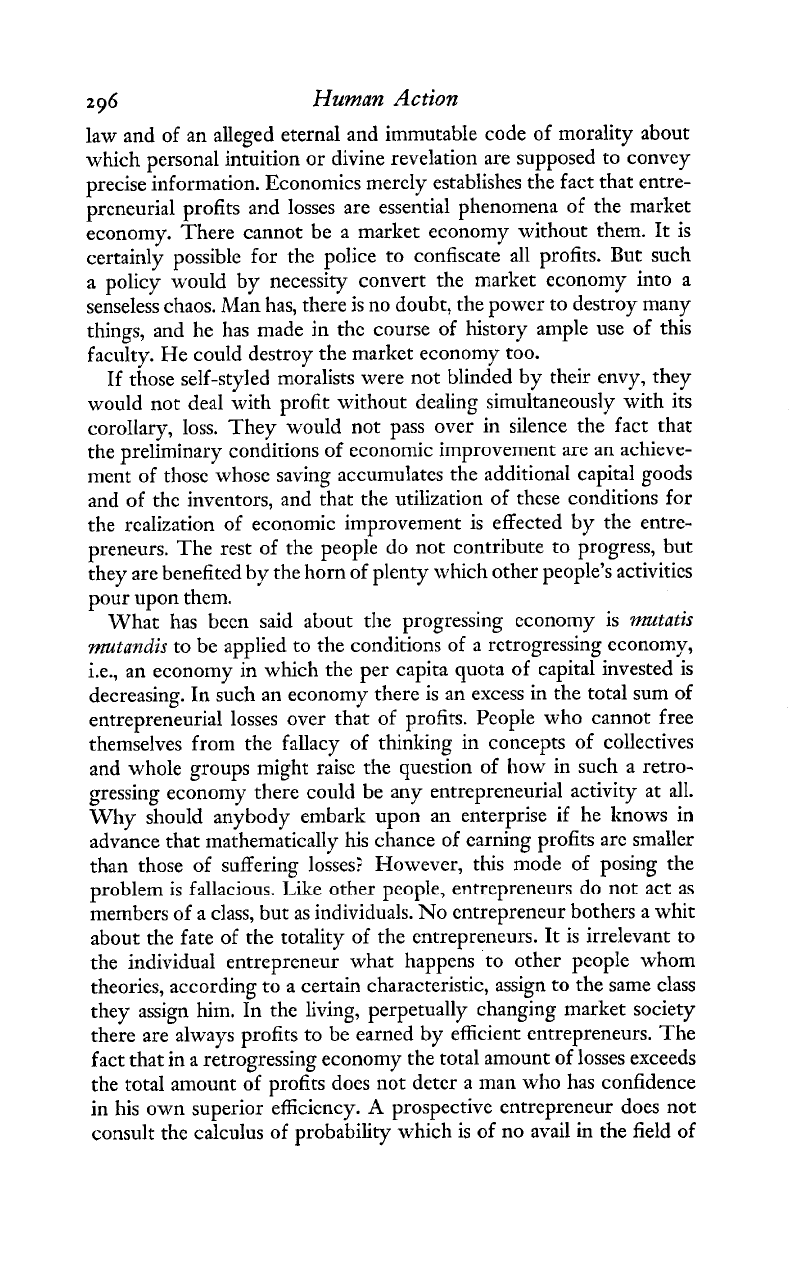
296
Human Action
law and of an alleged eternal and immutable code of morality about
which personal intuition or divine revelation are supposed to convey
precise information. Economics merely establishes the fact that entre-
preneurial profits and losses are essential phenomena of the market
economy. There cannot be a market economy without them. It is
certainly possible for the police to confiscate all profits. But such
a
policy would by necessity convert the market economy into
a
senseless chaos. Man has, there is no doubt, the power to destroy many
things, and he has made in the course of history ample use of this
faculty. He could destroy the market economy too.
If those self-styled moralists were not blinded by their envy, they
would not deal with profit without dealing simultaneously with its
corollary, loss. They would not pass over in silence the fact that
the preliminary conditions of economic i~nprovement arc an achieve-
ment of those whose saving accumulates the additional capital goods
and of the inventors, and that the utilization of these conditions for
the realization of economic improvement is effected by the entre-
preneurs. The rest of the people do not contribute to progress, but
they are benefited by the horn of plenty which other people's activities
pour upon them.
What has been said about the progressing economy is
wmtatis
mutandis
to be applied to the conditions of a retrogressing economy,
i.e., an economy in which the per capita quota of capital invested is
decreasing. In such an economy there is an excess in the total sum of
entrepreneurial losses over that of profits. People who cannot free
themselves from the fallacy of thinking in concepts of collectives
and whole groups might raise the question of how in such
a
retro-
gressing economy there could be any entrepreneurial activity at all.
Why should anybody embark upon an enterprise if he ltnows in
advance that mathematically his chance of earning profits arc smaller
than those of suffering losses? However, this mode of posing the
~rnhlem
is fallacious.
Like
other
people?
entrepreneurs do not act as
members of a class, bur as individuals. No entrepreneur bothers a whit
about the fate of the totality of the entrepreneurs. It is irrelevant to
the individual entrepreneur what happens to other people whom
theories, according to a certain characteristic, assign to the same class
they assign hi~n. In the living, perpetually changing market society
there are always profits to be earned by efficient entrepreneurs. The
fact that in a retrogressing economy the total amount of losses exceeds
the total amount of profits does not deter a man who has confidence
in
his own superior efficiency.
A
prospective entrepreneur does not
consult the calculus of probability which is of no avail in the field of
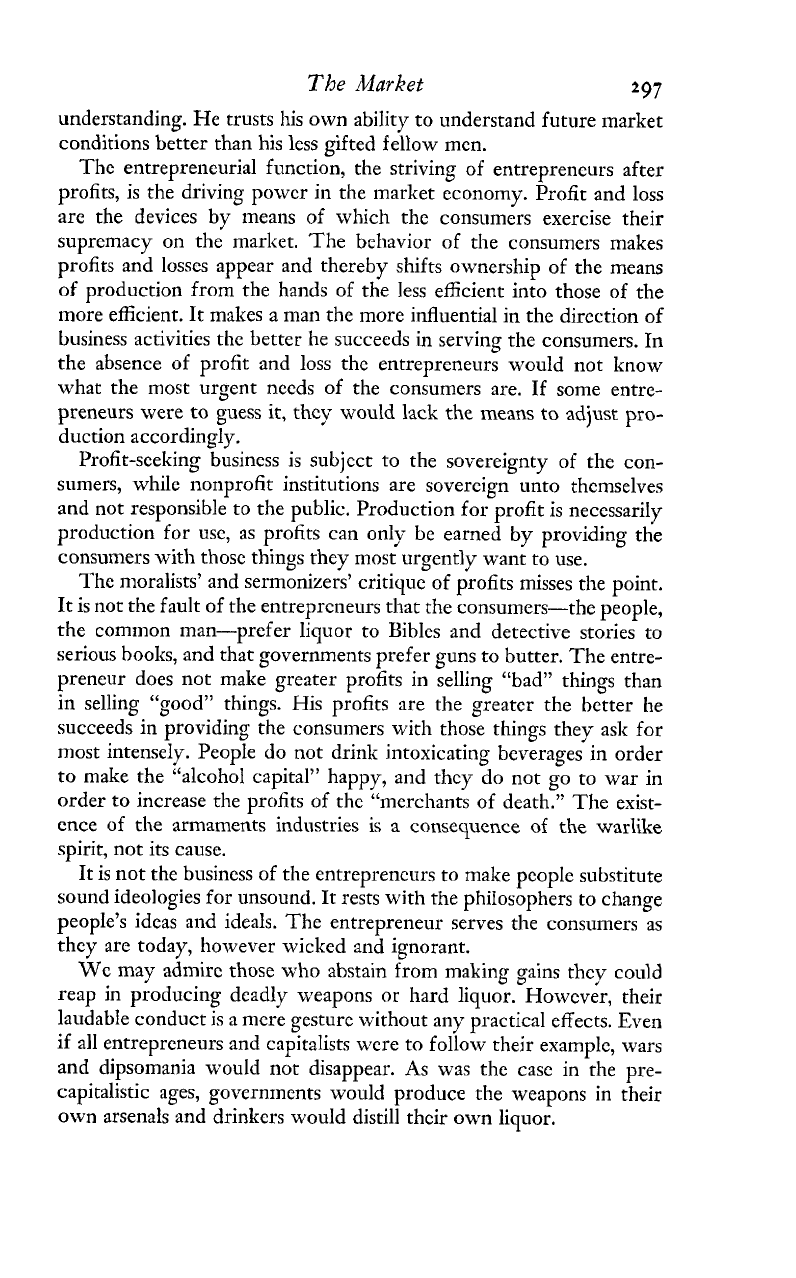
The
Market
297
understanding. He trusts his own ability to understand future market
conditions better than his less gifted fellow men.
The entrepreneurial function, the striving of entrepreneurs after
profits, is the driving power in the market economy. Profit and loss
are the devices by means of which the consumers exercise their
supremacy on the market. The behavior of the consumers makes
profits and losses appear and thereby shifts ownership of the means
of production from the hands of the less efficient into those of the
more efficient. It makes a man the more influential in the direction of
business activities the better he succeeds
in
serving the consumers. In
the absence of profit: and loss the entrepreneurs would not know
what the most urgent needs of the consumers are. If some entre-
preneurs were to guess it,
they
would lack the means to adjust pro-
duction accordingly.
Profit-seeking business is subject to the sovereignty of the con-
sumers, while nonprofit institutions are sovereign unto themselves
and not responsible to the public. Production for profit is necessarily
production for use, as profits can only be earned by providing the
consumers
with
those things they most urgently want to use.
The moralists' and sermonizers' critique of profits misses the point.
It is not the fault of the entrepreneurs that the consumers-the people,
the common man-prefer liquor to Bibles and detective stories to
serious books, and that governments prefer guns to butter. The entre-
preneur does not make greater profits in selling "bad" things than
in selling "good" things. His profits are the greater the better he
succeeds in providing the consumers with those things they ask for
most intensely. People do not drink intoxicating beverages in order
to make the "alcohol capital" happy, and thcy do not go to war in
order to increase the profits of the "merchants of death." The exist-
ence of the armaments industries is a consequence
of
the
warlike
spirit, not its cause.
It is not the business of the entrepreneurs to make people substitute
sound ideologies for unsound.
It
rests with the philosophers to change
people's ideas and ideals. The entrepreneur serves the consumers as
thcy are today, however wicked and ignorant.
We
may admire those who abstain from making gains they co~lld
reap in producing deadly weapons or hard liquor. However, their
laudable conduct is a mere gesture without any practical effects. Even
if all entrepreneurs and capitalists were to follow their example, wars
and dipsomania would not disappear. As was the case in the pre-
capitalistic ages, governments would produce the weapons in their
own arsenals and drinkers would distill their own liquor.
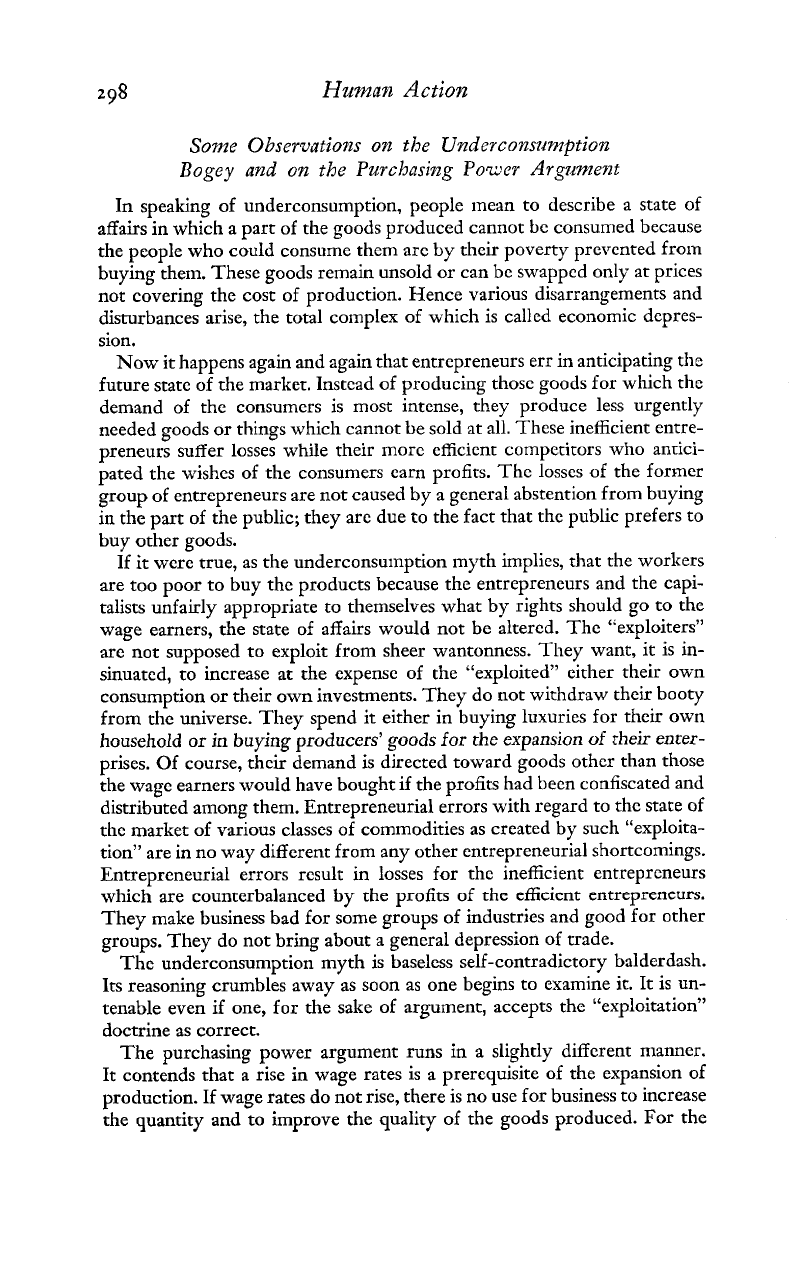
Human
Action
Sonze Observations on the Underconsumption
Bogey and on the Purchclsing Power Argument
In speaking of underconsumption, people mean to describe a state of
affairs in which a part of the goods produced cannot
be
consumed because
the people who could consume them arc by their poverty prevented from
buying them. These goods remain unsold or can be swapped only at prices
not covering the cost of production. Hence various disarrangements and
disturbances arise, the total complex of which is called economic depres-
sion.
Now it happens again and again that entrepreneurs err in anticipating the
future state of the market. Instead of producing those goods for which the
demand of the consumers is most intense, they produce less urgently
needed goods or things which cannot be sold at all. These inefficient entre-
preneurs suffer losses while their more efficient competitors who antici-
pated the wishes of the consumers earn profits. The losses of the former
group of entrepreneurs are not caused by a general abstention from buying
in the part of the public; they arc due to the fact that the public prefers to
buy other goods.
If it were true, as the underconsumption myth implies, that the workers
are too poor to buy the products because the entrepreneurs and the capi-
talists unfairly appropriate to themselves what by rights should go to the
wage earners, the state of affairs would not be altered. The "exploiters"
are
not supposed to exploit from sheer wantonness. They want, it is in-
sinuated, to increase at the expense of the "exploited" either their own
consumption or their own investments. They do not wichdraw their booty
from the universe. They spend it either in buying luxuries for their own
household or in buying producers' goods for the expansion
of
their enter-
prises. Of course, their demand is directed toward goods other than those
the wage earners would have bought if the profits had been confiscated and
distributed among them. Entrepreneurial errors with regard to the state of
the market of various classes of commodities as created by such "exploita-
tion" are in no way different from any other entrepreneurial shortcomings.
Entrepreneurial errors result in losses for the inefficient entrepreneurs
which are counterbalanced by the profits of the efficient entrepreneurs.
They make business bad for some groups of industries and good for other
groups. They do not bring about a general depression of trade.
The underconsumption myth is baseless self-contradictory balderdash.
Its reasoning crumbles away as soon as one begins to examine it. It is un-
tenable even if one, for the sake of argument, accepts thc "exploitation"
doctrine as correct.
The purchasing power argument runs in a slightly different manner.
It contends that a rise in wage rates is a prerequisite of the expansion of
production. If wage rates do not rise, there is no use for business to increase
the quantity and to improve the quality of the goods produced. For the
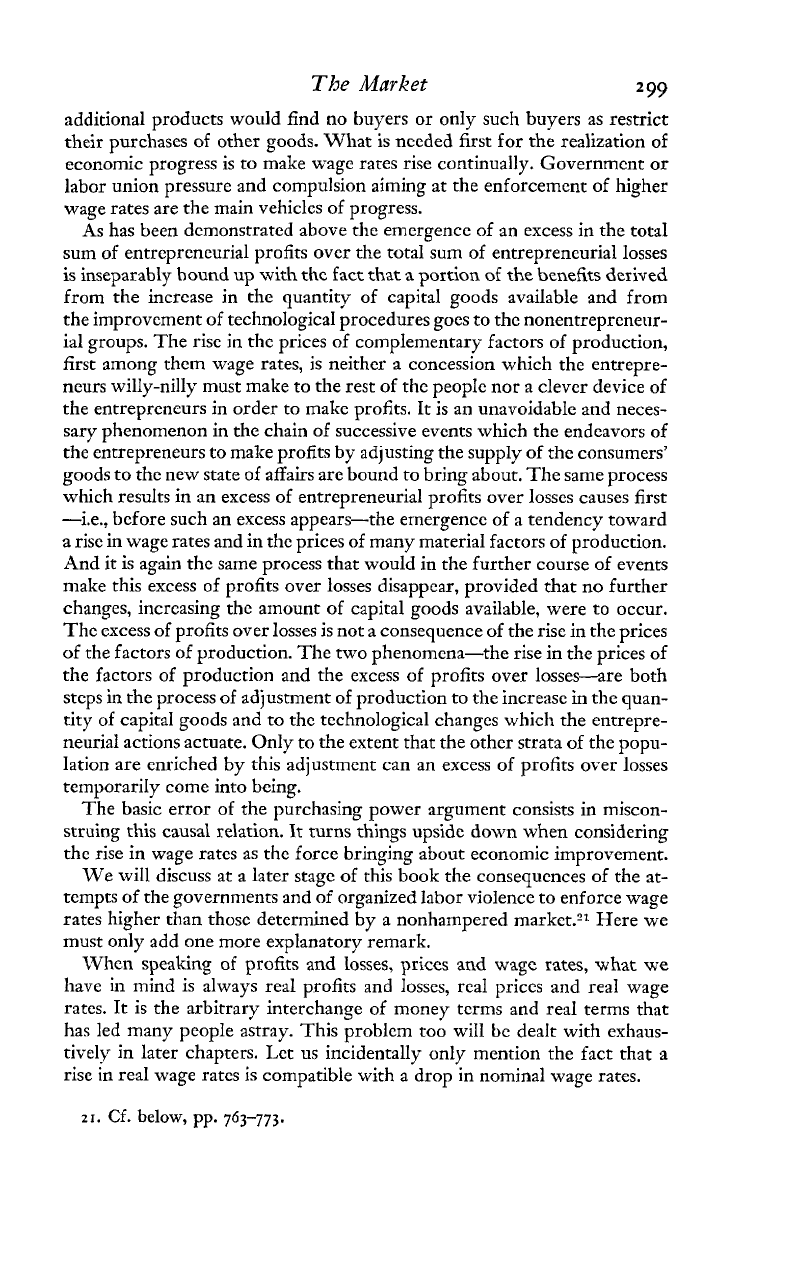
The
Market
additional products would find no buyers or only such buyers as restrict
their purchases of other goods. What is needed first for the realization of
economic progress is to make wage rates rise continually. Government or
labor union pressure and compulsion aiming at the enforcement of higher
wage rates are the main vehicles of progress.
As has been demonstrated above the emergence of an excess in the total
sum of entrepreneurial profits over the total sum of entrepreneurial losses
is
inseparably hound up with the fact that a portion of the benefits derived
from the increase in the quantity of capital goods available and from
the improvement of technological procedures goes to the nonentrepreneur-
ial groups. The rise in the prices of complementary factors of production,
first among them wage rates, is neither a concession which the entrepre-
neurs willy-nilly must make to the rest of the people nor a clever device of
the entrepreneurs in order to make profits. It is an unavoidable and neces-
sary phenomenon in the chain of successive events which the endeavors of
the entrepreneurs to make profits
by
adjusting the supply of the consumers'
goods to the new state of affairs are bound to bring about. The same process
which results in an excess of entrepreneurial profits over losses causes first
-i.e., before such an excess appears-the emergence of a tendency toward
a rise in wage rates and in the prices of many material factors of production.
And it is again the same process that would in the further course of events
make this excess of profits over losses disappear, provided that no further
changes, increasing the amount of capital goods available, were to occur.
The cxcess of profits over losses is not a consequence of the rise in the prices
of the factors of production. The two phenomena-the rise in the prices of
the factors of production and the excess of profits over losses-are both
steps in the process of adjustment of production to the increase in the quan-
tity of capital goods and to the technological changes which the entrepre-
neurial actions actuate. Only to the extent that the other strata of the popu-
lation are enriched by this adjustment can an excess of profits over losses
temporarily come into being.
The basic error of the purchasing power argument consists in miscon-
struing this causal relation. It turns things upside down when considering
the rise in wage rates as the force bringing about economic improvement.
We will discuss at a later stage of this book the consequences of the at-
tempts of the governments and of organized labor violence to enforce wage
rates higher than those determined by a nonharnpered market.?l Here we
must only add one more explanatory remark.
When speaking of profits and losses, priccs and
wage
rates, what
we
have in mind is always real profits and losses, real prices and real wage
rates. It is the arbitrary interchange of money terms and real terms that
has led many people astray. This problem too will be dealt with exhaus-
tively in later chapters. Let us incidentally only mention the fact that a
rise in real wage rates is compatible with a drop in nominal wage rates.
21.
Cf.
below,
pp.
763-773.

300
Human
Action
I
o. Promoters, Managers, Technicians,
and
Bureaucrats
The entrepreneur hires the technicians, i.e., people who have the
ability and the skill to perform definite kinds and quantities of work.
The class of technicians includes the great inventors, the champions
in the field of applied science, the constructors and designers as we11
as the performers of the most simple tasks. The entrepreneur joins
their ranks as far as he himself takes part in the technical execution of
his entrepreneurial plans. The technician contributes his own toil
and trouble; but it is the entrepreneur qua entrepreneur who directs
his labor toward definite goals. And the entrepreneur himself acts as
a
mandatary, as it were, of the consumers.
The entrepreneurs are not omnipresent. They cannot themselves
attend to the manifold tasks which are incumbent upon them. Adjust-
ment of production
to
the best possible supplying of the consumers
with the goods they are asking for most urgently does not merely
consist in determining the general plan for the utilization of resources.
There is, of course, no doubt that this is the main function of the
promoter and speculator. But besides the great adjustments, many
small adjustments are necessary too. Each of them may seem trifling
and of little bearing upon the total result. But the
cumulative
effect
of shortcomings in many of these minor matters can be such as to
frustrate entirely the success of a correct solution of the great prob-
lems. At any rate, it is certain that every failure to handle the smaller
problems results in a squandering of scarce factors of production and
consequently in impairing the best possible satisfaction of the con-
sumers.
It
is important to conceive in what respects the problem we have
in mind differs from the technological tasks of the technicians.
The
execution of every project upon which the entrepreneur has em-
barked in making his decision
~411
regard to the general plan of
action requires a multiplicity of minute decisions. Each of these de-
cisions must be efiected in such a way as to prefer that soiution of
the problem which-without interfering with the designs of the
general plan for the whole project-is the most economical one. It
must avoid superfluous costs in the same way as does the general plan.
The technician from his purely technological point of view either
may not see any difference in the alternatives offered by various
meihods for thesolution of such a detail or may give preference to
one of these methods on account of its greater output in phvsical
quantities. But the entrepreneur
is
actuated by the profit motive: This
enjoins upon him the urge to prefer the most economical solution, i.e.,
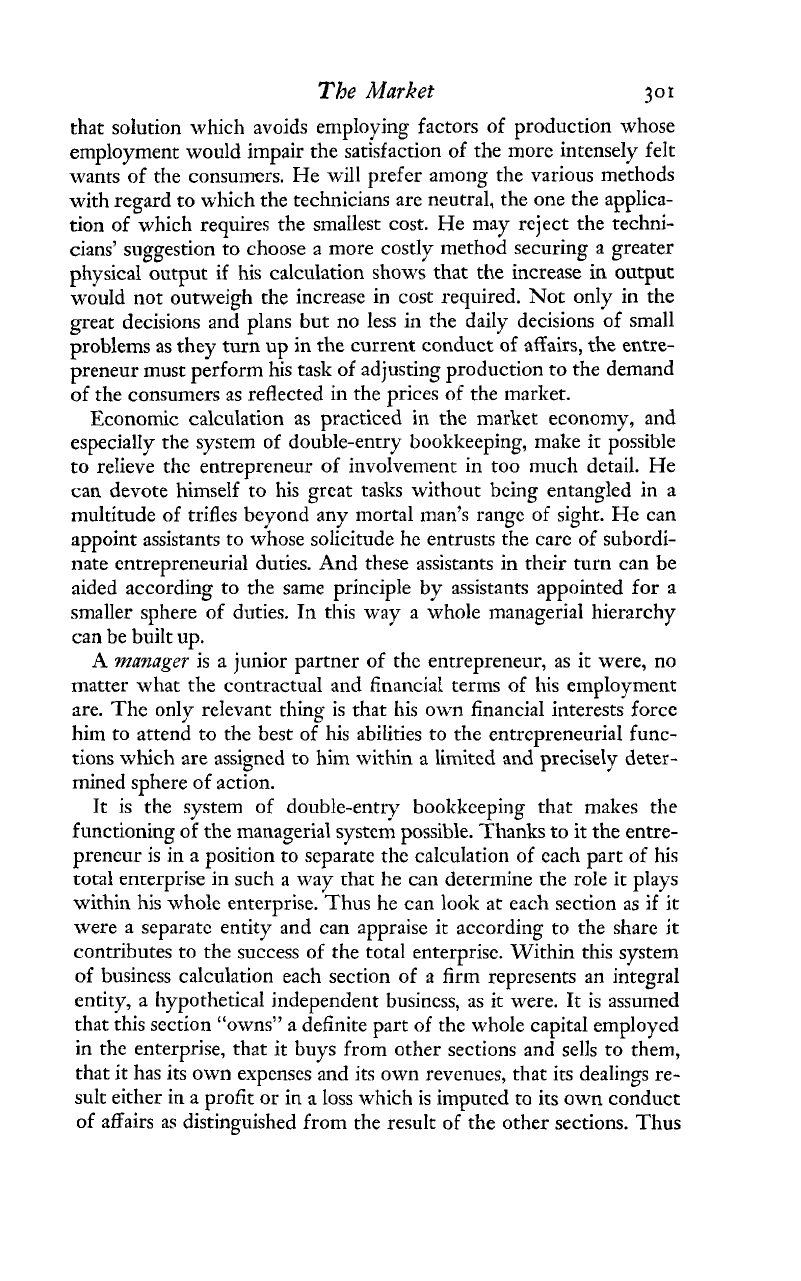
The
Market
301
that solution which avoids employing factors of production whose
employment would impair the satisfaction of the more intensely felt
wants of the consumcrs. He will prefer among the various methods
with regard to which the technicians are neutral, the one the applica-
tion of which requires the smaIlest cost. He may reject the techni-
cians' suggestion to choose a more costly method securing a greater
physical output if his calculation shows that the increase
in
output
would not outweigh the increase in cost required. Not only in the
great decisions and plans but no less in the daily decisions of small
problems as they turn up in the current conduct
of
affairs, the entre-
preneur must perform his task of adjusting production to the demand
of the consumers as reflected in the prices
of
the market.
Economic calculation as practiced
in
the market economy, and
especialIy the system of double-entry bookkeeping, make it possible
to reIieve the entrepreneur of involvement in too much detail. He
can devote himself to his great tasks without being entangled in a
multitude of trifles beyond any mortal man's range of sight.
He
can
appoint assistants to whose solicitude he entrusts the care of subordi-
nate entrepreneurial duties. And these assistants in their turn can be
aided according to the same principle by assistants appointed for a
smaller sphere of duties. In this way a whole managerial hierarchy
can be built up.
A
manager
is a junior partner of thc entrepreneur, as it were, no
matter what the contractual and financial terms of his employment
are. The only relevant thing is that his own financial interests force
him to attend to the best of his abilities to the entrepreneurial func-
tions which are assigned to him within
a
limited and precisely deter-
mined sphere of action.
It is the system of double-entv bookkeeping that makes
the
functioning of the managerial syste& possible. Thanks to it the entre-
prencur is in a position to separate the calculation of each part of his
total enterprise in such a way that he can determine the role it plays
within his whole enterprise. Thus he can look at each section as
if
it
were a separatc entity and can appraise it according to the share it
contributes to the success of the total enterprisc. Within this system
of business calculation each section of a firm represents an integral
entity, a hypothetical independent business, as it were. It is assumed
that this section "owns" a definite part of the whole capital employed
in the enterprise, that it buys from other sections and sells to them,
that it has its own expenses and its own revenues, that its dealings re-
sult either in a profit or in a loss which is imputed to its own conduct
of affairs as distinguished from the result of the other sections.
Thus
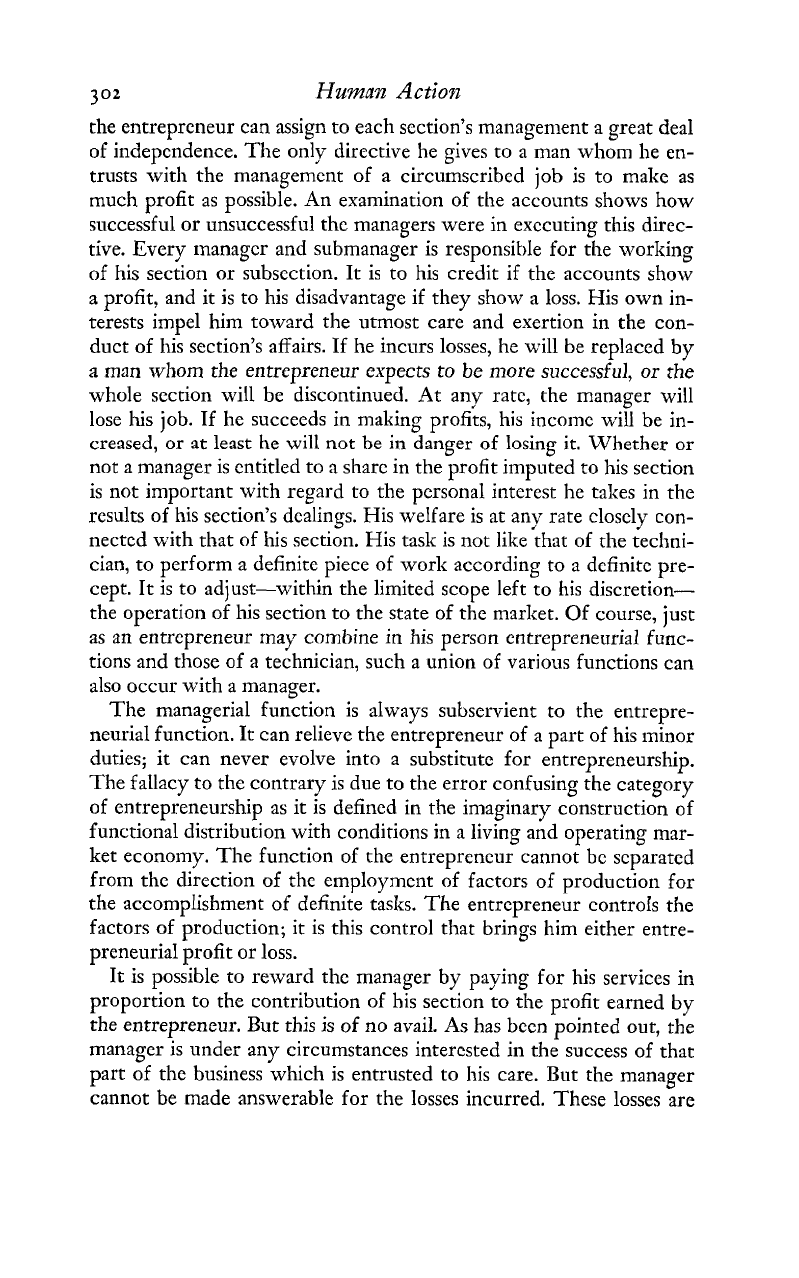
302
Human
Action
the entrepreneur can assign to each section's management a great deal
of indepcndence. The only directive he gives to a man whom he en-
trusts with the managerncnt of a circumscribed job is to make as
much profit as possible. An examination of the accounts shows how
successful or unsuccessful the managers were in exccuting this direc-
tive. Every tnanagcr and submanager is responsible for the working
of his section or subsection. It is to his credit if the accounts show
a
profit, and it is to his disadvantage if they show a loss. His own in-
terests impel him toward the utmost care and exertion in the con-
duct of his section's affairs. If he incurs losses, he will be replaced by
a
man whom the entrepreneur expects to be more successful, or
the
whole section will be discontinued. At any rate, the manager will
lose his job. If he succeeds in making profits, his income will be in-
creased, or at least he will not be in danger of losing it. Whether or
not a manager is entitled to
a
share in the profit imputed to his section
is not important with regard to the personal intcrest he takes in the
results of his section's dealings. His welfare is at any rate closely con-
nected with that of his section. His task is not like that of the techni-
cian, to perform a definite piece of work according to a definite pre-
cept. It is to adjust-within the limited scope left to his discretion-
the opcration of his section to the state of the market. Of course, just
as an entrepreneur
may
combine in his person entrepreneurial func-
tions and those of a technician, such a union of various functions can
also occur with a manager.
The managerial function is aIways subservient to the entrepre-
neurial function. It can relieve the entrepreneur of a part of his minor
duties; it can never evolve into
a
substitute for entrepreneurship.
The fallacy to the contrary is due to the error confusing the category
of entrepreneurship as it is defined in the imaginary construction of
functional distribution with conditions in
a
living and operating mar-
ket economy. The function of the entrepreneur cannot be separated
from the direction of the employment of factors of production for
the accomplishment of definite tasks. The entrcpreneur controIs the
factors of production; it is this control that brings him either entre-
preneurial profit or loss.
It
is
possible to reward the manager by paying for his services in
proportion to the contribution of his section to the profit earned by
the entrepreneur. But this
is
of no avail. As has been pointed out, the
managcr is under any circumstances interested in the success of that
part of the business which is entrusted to his care. But the manager
cannot be made answerable for the losses incurred. These losses are
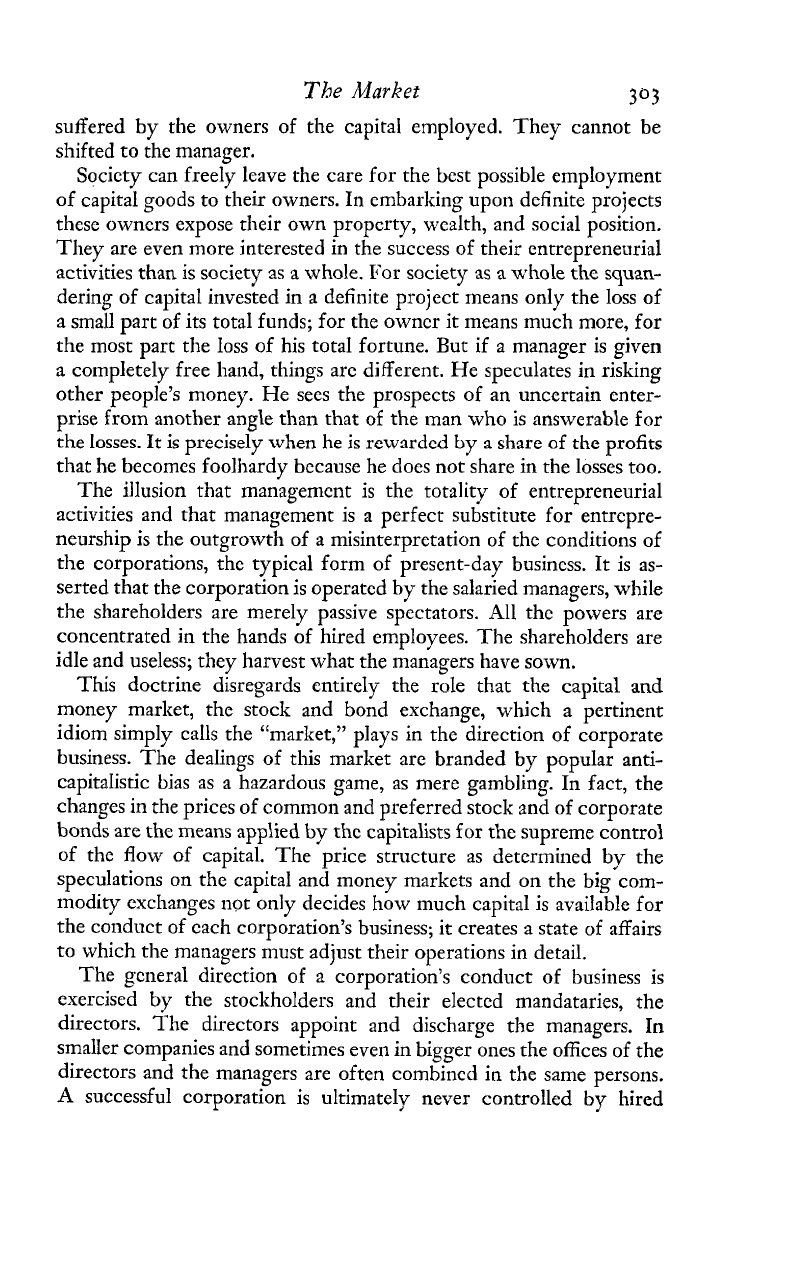
The
Market
303
suffered by the owners of the capital employed. They cannot be
shifted to the manager.
Society can freely leave the care for the best possible employment
of capital goods to their owners. In embarking upon definite projects
these owners expose their own property, wealth, and social position.
They are even more interested in the success of their
entrepreneurial
activities than is society as a whole. For society
as
a
whole the squan-
dering of capital invested in a definite project means only the loss
of
a small part of its total funds; for the owner it means much more, for
the most part the loss of his total fortune. But if a manager is given
a completely free band, things are different. He speculates in risking
other people's money. He sees the prospects of an uncertain enter-
prise from another angle than that of the man who is answerable for
the losses. It is precisely when he is rewarded by a share of the profits
that he becomes foolhardy because
he
does not share in the losses too.
The illusion that management is the totality of entrepreneurial
activities and that management is a perfect substitute for entrepre-
neurship is the outgrowth of a misinterpretation of the conditions of
the corporations, the typical form of present-day business. It is as-
serted that the corporation is operated by the salaried managers, while
the shareholders are merely passive spectators. All the powers are
concentrated in the hands of hired employees. The shareholders are
idle and useless; they harvest what the managers have sown.
This doctrine disregards entireIy the role that the capital
and
money market, the stock and bond exchange, which a pertinent
idiom simply calls the "market," plays in the direction of corporate
business. The dealings of this market are branded by popular anti-
capitalistic bias as a hazardous game, as mere gambling. In fact, the
changes in the prices of common and preferred stock and of corporate
bonds are the means applied
by
the capitalists for the supreme control
of the flow of capital. The price structure as determined by the
speculations on the capital and money markets and on the big com-
~nodity exchanges not only decides how much capital is available for
the conduct of each corporation's business; it creates a state of affairs
to which the managers must adjust their operations in detail.
The general direction of
a
corporation's conduct of business
is
exercised by the stockholders and their elected mandataries, the
directors. The directors appoint and discharge the managers. In
smaller companies and sometimes even in bigger ones the offices of the
directors and the managers are often combined in the same persons.
A
successful corporation is ultimately never controlled by hired
